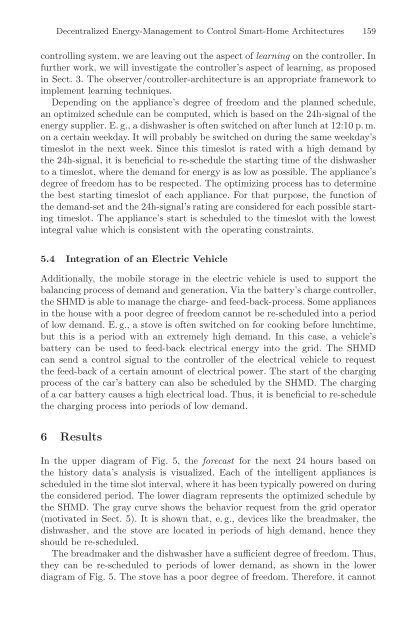Architecture of Computing Systems (Lecture Notes in Computer ...
Architecture of Computing Systems (Lecture Notes in Computer ...
Architecture of Computing Systems (Lecture Notes in Computer ...
Create successful ePaper yourself
Turn your PDF publications into a flip-book with our unique Google optimized e-Paper software.
Decentralized Energy-Management to Control Smart-Home <strong>Architecture</strong>s 159<br />
controll<strong>in</strong>g system, we are leav<strong>in</strong>g out the aspect <strong>of</strong> learn<strong>in</strong>g on the controller. In<br />
further work, we will <strong>in</strong>vestigate the controller’s aspect <strong>of</strong> learn<strong>in</strong>g, as proposed<br />
<strong>in</strong> Sect. 3. The observer/controller-architecture is an appropriate framework to<br />
implement learn<strong>in</strong>g techniques.<br />
Depend<strong>in</strong>g on the appliance’s degree <strong>of</strong> freedom and the planned schedule,<br />
an optimized schedule can be computed, which is based on the 24h-signal <strong>of</strong> the<br />
energy supplier. E. g., a dishwasher is <strong>of</strong>ten switched on after lunch at 12:10 p. m.<br />
on a certa<strong>in</strong> weekday. It will probably be switched on dur<strong>in</strong>g the same weekday’s<br />
timeslot <strong>in</strong> the next week. S<strong>in</strong>ce this timeslot is rated with a high demand by<br />
the 24h-signal, it is beneficial to re-schedule the start<strong>in</strong>g time <strong>of</strong> the dishwasher<br />
to a timeslot, where the demand for energy is as low as possible. The appliance’s<br />
degree <strong>of</strong> freedom has to be respected. The optimiz<strong>in</strong>g process has to determ<strong>in</strong>e<br />
the best start<strong>in</strong>g timeslot <strong>of</strong> each appliance. For that purpose, the function <strong>of</strong><br />
the demand-set and the 24h-signal’s rat<strong>in</strong>g are considered for each possible start<strong>in</strong>g<br />
timeslot. The appliance’s start is scheduled to the timeslot with the lowest<br />
<strong>in</strong>tegral value which is consistent with the operat<strong>in</strong>g constra<strong>in</strong>ts.<br />
5.4 Integration <strong>of</strong> an Electric Vehicle<br />
Additionally, the mobile storage <strong>in</strong> the electric vehicle is used to support the<br />
balanc<strong>in</strong>g process <strong>of</strong> demand and generation. Via the battery’s charge controller,<br />
the SHMD is able to manage the charge- and feed-back-process. Some appliances<br />
<strong>in</strong> the house with a poor degree <strong>of</strong> freedom cannot be re-scheduled <strong>in</strong>to a period<br />
<strong>of</strong> low demand. E. g., a stove is <strong>of</strong>ten switched on for cook<strong>in</strong>g before lunchtime,<br />
but this is a period with an extremely high demand. In this case, a vehicle’s<br />
battery can be used to feed-back electrical energy <strong>in</strong>to the grid. The SHMD<br />
can send a control signal to the controller <strong>of</strong> the electrical vehicle to request<br />
the feed-back <strong>of</strong> a certa<strong>in</strong> amount <strong>of</strong> electrical power. The start <strong>of</strong> the charg<strong>in</strong>g<br />
process <strong>of</strong> the car’s battery can also be scheduledbytheSHMD.Thecharg<strong>in</strong>g<br />
<strong>of</strong> a car battery causes a high electrical load. Thus, it is beneficial to re-schedule<br />
the charg<strong>in</strong>g process <strong>in</strong>to periods <strong>of</strong> low demand.<br />
6 Results<br />
In the upper diagram <strong>of</strong> Fig. 5, the forecast for the next 24 hours based on<br />
the history data’s analysis is visualized. Each <strong>of</strong> the <strong>in</strong>telligent appliances is<br />
scheduled <strong>in</strong> the time slot <strong>in</strong>terval, where it has been typically powered on dur<strong>in</strong>g<br />
the considered period. The lower diagram represents the optimized schedule by<br />
the SHMD. The gray curve shows the behavior request from the grid operator<br />
(motivated <strong>in</strong> Sect. 5). It is shown that, e. g., devices like the breadmaker, the<br />
dishwasher, and the stove are located <strong>in</strong> periods <strong>of</strong> high demand, hence they<br />
should be re-scheduled.<br />
The breadmaker and the dishwasher have a sufficient degree <strong>of</strong> freedom. Thus,<br />
they can be re-scheduled to periods <strong>of</strong> lower demand, as shown <strong>in</strong> the lower<br />
diagram <strong>of</strong> Fig. 5. The stove has a poor degree <strong>of</strong> freedom. Therefore, it cannot


